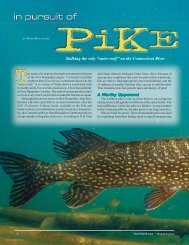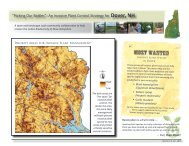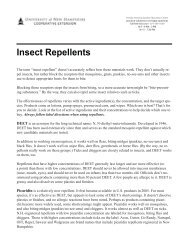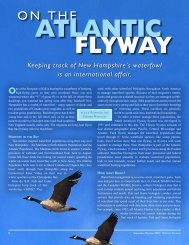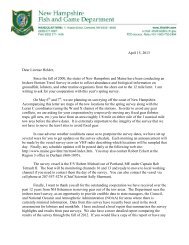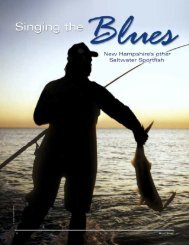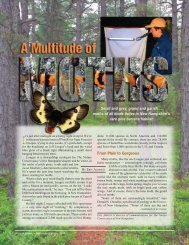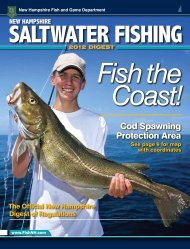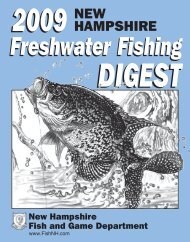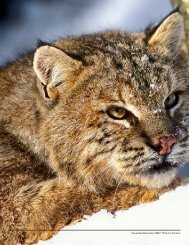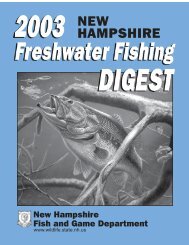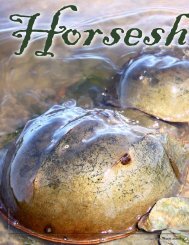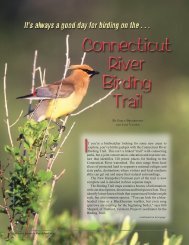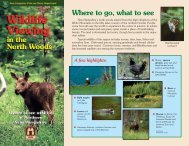Springtime... and the living is not easy - New Hampshire Fish and ...
Springtime... and the living is not easy - New Hampshire Fish and ...
Springtime... and the living is not easy - New Hampshire Fish and ...
Create successful ePaper yourself
Turn your PDF publications into a flip-book with our unique Google optimized e-Paper software.
©ROGER IRWIN PHOTO<br />
©BEN KILHAM PHOTO<br />
4 March/April 2003 • WILDLIFE JOURNAL
In <strong>New</strong> <strong>Hampshire</strong>, we regard spring as an<br />
arrival — a deliverance, really. It’s a reward<br />
we’ve well earned, thank you, with our aching<br />
backs, cold-stung fingers <strong>and</strong> deathdefying<br />
commutes. We may be forgiven if we<br />
gloat about “making it through ano<strong>the</strong>r <strong>New</strong><br />
Engl<strong>and</strong> winter.”<br />
For many wildlife species, though, spring<br />
doesn’t mark <strong>the</strong> end of winter travails as much as<br />
it signals <strong>the</strong> beginning of a gauntlet of new<br />
challenges. Some animals are at <strong>the</strong>ir most vulnerable<br />
now. Females are ei<strong>the</strong>r pregnant or ra<strong>is</strong>ing<br />
<strong>the</strong>ir young; males are competing for breeding<br />
grounds <strong>and</strong> mates. Food can be scarce. Capricious<br />
spring storms wash eggs from <strong>the</strong>ir nests or<br />
freeze <strong>the</strong>m where <strong>the</strong>y lie. Wind, sleet <strong>and</strong> snow<br />
chill young animals, <strong>and</strong> death may follow soon<br />
after birth.<br />
Fortunately, animals come equipped to cope<br />
with most of what spring hurls at <strong>the</strong>m. Their<br />
amazing strategies, both behavioral <strong>and</strong> physiological,<br />
may delight, d<strong>is</strong>turb or even d<strong>is</strong>gust us<br />
humans — but <strong>the</strong>y’re all done with <strong>the</strong> singular<br />
purpose of surviving spring.<br />
Protective Parenting Strategies<br />
Spring can be a particularly tough time for<br />
black bears, especially for sows with cubs in tow.<br />
Unless <strong>the</strong> previous fall offered a bumper crop of<br />
acorns <strong>and</strong> beech nuts, bears find foraging bleak<br />
when emerging from <strong>the</strong>ir dens in early April.<br />
Snow still covers <strong>the</strong> ground <strong>and</strong> few plants are<br />
growing in earnest. Bears must rely on fat reserves<br />
from fall that got <strong>the</strong>m through <strong>the</strong> winter.<br />
“It appears that adult bears continue to lose<br />
weight through June <strong>and</strong> into July,” says wildlife<br />
biolog<strong>is</strong>t Mark Ellingwood of N.H. F<strong>is</strong>h <strong>and</strong> Game.<br />
That’s why bears often head to <strong>the</strong> wetl<strong>and</strong>s,<br />
where spring’s first table <strong>is</strong> set with grasses, forbs<br />
(broad-leafed herbs) <strong>and</strong> tubers. “Skunk cabbage<br />
<strong>is</strong> extremely popular, but jack-in-<strong>the</strong>-pulpit <strong>is</strong><br />
preferred,” Ellingwood says. “They pull <strong>the</strong> plant<br />
<strong>and</strong> eat <strong>the</strong> tubers. The vegetative growth <strong>is</strong> a flag<br />
to <strong>the</strong>m that <strong>the</strong>re’s a tuber underneath.”<br />
Bears often don’t start rebounding until later in<br />
<strong>the</strong> spring, when berries begin to ripen <strong>and</strong> o<strong>the</strong>r<br />
foods are plentiful. Until <strong>the</strong>n, <strong>the</strong>y must make do<br />
— which for female bears typically means nursing<br />
one, two or three cubs while teaching <strong>the</strong>m<br />
how to survive.<br />
Bear researcher Ben Kilham of Lyme, coauthor<br />
of Among <strong>the</strong> Bears, has spent countless<br />
hours watching sows giving cubs <strong>the</strong>ir first survival<br />
lessons. “The mo<strong>the</strong>r bear teaches <strong>the</strong> young<br />
what to eat by transferring smell by her breath. It’s<br />
JOHN P GREEN PHOTO<br />
an olfactory invitation,” Kilham says.<br />
The sow eats a bit, <strong>the</strong>n lets her cubs sniff her<br />
mouth. They <strong>the</strong>n recognize that smell when <strong>the</strong>y<br />
come across it. Kilham, who d<strong>is</strong>covered that bears<br />
have an organ in <strong>the</strong>ir mouths that allows <strong>the</strong>m to<br />
d<strong>is</strong>cern differences between plants, says that cubs<br />
can teach <strong>the</strong>mselves what to eat by mouthing<br />
vegetation. They’ll eat what’s edible <strong>and</strong> leave<br />
behind <strong>the</strong> rest.<br />
Bears in spring also eat <strong>the</strong> scat from deer <strong>and</strong><br />
moose, Kilham says. “They only eat <strong>the</strong> freshest<br />
scat,” he says, because it contains organ<strong>is</strong>ms <strong>the</strong>y<br />
need to digest beech <strong>and</strong> ash buds, red maple<br />
flowers <strong>and</strong> o<strong>the</strong>r foods difficult for non-ungulate<br />
stomachs to break down.<br />
Sometimes, even <strong>the</strong> most dedicated bear<br />
mo<strong>the</strong>r needs a break from her cubs. Kilham says<br />
sows will pick what he calls a babysitting tree – a<br />
large pine or hemlock. Once her cubs have scooted<br />
up <strong>the</strong> tree, she leaves <strong>the</strong>m <strong>the</strong>re to go find food<br />
on her own nearby. Up in <strong>the</strong>ir babysitting tree,<br />
cubs practice <strong>the</strong>ir climbing skills <strong>and</strong> are safer<br />
from predators like bobcats <strong>and</strong> coyotes than <strong>the</strong>y<br />
would be on <strong>the</strong> ground.<br />
continued on next page<br />
A white-tailed deer<br />
fawn “hides in plain<br />
sight,” while h<strong>is</strong><br />
mo<strong>the</strong>r forages for<br />
food.<br />
BY<br />
BRENDA CHARPENTIER<br />
Brenda Charpentier of<br />
Sanbornton writes for<br />
<strong>the</strong> Nongame <strong>and</strong><br />
Endangered Wildlife<br />
Program’s newsletter,<br />
Wildlines.<br />
WILDLIFE JOURNAL • March/April 2003 5
River otter swimming<br />
lesson: Mom nudges<br />
a reluctant kit into<br />
<strong>the</strong> water.<br />
The Call to Crawl<br />
continued from previous page<br />
In <strong>the</strong> case of white-tailed deer, <strong>the</strong> ground <strong>is</strong><br />
exactly where newborn fawns seek protection,<br />
“hiding in plain sight.” Fawns’ coats are mottled;<br />
<strong>the</strong>y blend in with grass <strong>and</strong> o<strong>the</strong>r plants, so<br />
mo<strong>the</strong>r deer hide <strong>the</strong>m <strong>the</strong>re when <strong>the</strong>y leave to<br />
One of nature’s most spectacular springtime<br />
events happens right under our noses <strong>and</strong> offers<br />
great wildlife viewing opportunities.<br />
As <strong>the</strong> ground begins to thaw, amphibians<br />
emerge from winter havens underground or on<br />
pond <strong>and</strong> stream bottoms <strong>and</strong> venture topside. These creatures <strong>the</strong>n answer<br />
inner calls to crawl or hop to annual breeding grounds.<br />
During th<strong>is</strong> migration, triggered by temperature <strong>and</strong> spring’s first rains,<br />
thous<strong>and</strong>s of salam<strong>and</strong>ers <strong>and</strong> frogs seem to throw caution to <strong>the</strong> wind,<br />
marching resolutely over roads <strong>and</strong> through <strong>the</strong> woods toward herpetological<br />
bl<strong>is</strong>s. If you’ve ever been out driving on one of <strong>the</strong>se nights <strong>and</strong> <strong>not</strong>iced an<br />
unbelievable number of frogs hopping in front of your headlights, you’ve<br />
witnessed th<strong>is</strong> migration.<br />
For spring peepers, wood frogs <strong>and</strong> spotted, Jefferson, blue-spotted <strong>and</strong><br />
marbled salam<strong>and</strong>ers, <strong>the</strong> destination <strong>is</strong> a vernal pool – those temporary pools<br />
of water that usually dry out by mid-summer but in spring offer a mating place<br />
free from predatory f<strong>is</strong>h.<br />
The best way to see <strong>the</strong> action requires some planning. First, locate a vernal<br />
pool in your area. Then, watch for <strong>the</strong> first one or two rainy nights of spring that<br />
are above 40 degrees F. When those nights arrive, bring along a flashlight <strong>and</strong><br />
venture out to <strong>the</strong> pool. St<strong>and</strong> quietly while shining <strong>the</strong> light into <strong>the</strong> pool <strong>and</strong>,<br />
if your timing <strong>is</strong> right, you’ll see <strong>the</strong>se amazing creatures up close.<br />
ERIC ALDRICH PHOTO<br />
©BILL SILLIKER, JR PHOTO<br />
forage for food. If a doe has twins, she finds<br />
separate hiding places for each; th<strong>is</strong> way, she<br />
reduces <strong>the</strong> chance that one successful predation<br />
will bring death to both of her fawns. She returns<br />
only a few times a day to nurse <strong>the</strong> fawns, who lie<br />
still while <strong>the</strong>y wait for her, with <strong>the</strong>ir chins flat on<br />
<strong>the</strong> ground to remain camouflaged.<br />
Female wild turkeys are alert parents as well.<br />
Turkey poults are born in early June with thin<br />
fea<strong>the</strong>rs; <strong>the</strong>y’re easily chilled, so female turkeys<br />
face <strong>the</strong> task of keeping <strong>the</strong>m dry <strong>and</strong> warm. Th<strong>is</strong><br />
can be difficult during cold spring storms, especially<br />
since poults can’t fly up into trees to roost<br />
until <strong>the</strong>y’re about two weeks old. For <strong>the</strong>se first<br />
vulnerable weeks, <strong>the</strong> female stays on <strong>the</strong> ground<br />
at night, her fea<strong>the</strong>rs fluffed out <strong>and</strong> her poults<br />
ga<strong>the</strong>red around, usually under a tree. By day, she<br />
takes <strong>the</strong>m out hunting for insects, catching bugs<br />
<strong>and</strong> tearing <strong>the</strong>m to pieces for her protein-needy<br />
poults. If one poult w<strong>and</strong>ers away <strong>and</strong> gets lost, it<br />
need only utter a panicked cry; <strong>the</strong> mo<strong>the</strong>r will<br />
stop <strong>and</strong> answer until <strong>the</strong> w<strong>and</strong>erer has followed<br />
<strong>the</strong> sound of her voice <strong>and</strong> rejoined <strong>the</strong> family.<br />
When it comes to parenting, humans should<br />
relate well to <strong>the</strong> river otter, who must make her<br />
kits do what’s good for <strong>the</strong>m even though <strong>the</strong>y<br />
don’t want to. We struggle to get our kids to eat<br />
<strong>the</strong>ir vegetables; river otters must often cajole,<br />
coax or force <strong>the</strong>ir kits to swim. Since f<strong>is</strong>h are<br />
otters’ main food source, survival <strong>is</strong> impossible<br />
for otters that can’t swim. Yet many kits don’t take<br />
to <strong>the</strong> water naturally. What’s a river otter mo<strong>the</strong>r<br />
6 March/April 2003 • WILDLIFE JOURNAL
to do but push <strong>the</strong>m in? Their teaching method <strong>is</strong><br />
truly sink or swim. An otter mom carries two or<br />
three kits on her back in <strong>the</strong> water, <strong>the</strong>n dives<br />
while <strong>the</strong> kits do <strong>the</strong>ir best to stay afloat. She<br />
returns to pick <strong>the</strong>m up, <strong>the</strong>n dives again, repeating<br />
<strong>the</strong> scenario until <strong>the</strong> kits are swimming on<br />
<strong>the</strong>ir own, like it or <strong>not</strong>.<br />
Clever Nesters<br />
Beginning life inside a small, breakable <strong>and</strong><br />
incredibly edible egg has its d<strong>is</strong>advantages. But<br />
birds employ at least as many strategies as <strong>the</strong>re<br />
are dangers.<br />
The ruby-throated hummingbird camouflages<br />
its inch-long nest by attaching it to a tree branch<br />
<strong>and</strong> covering <strong>the</strong> outside of it with gray-green<br />
lichens. The nest looks like just ano<strong>the</strong>r k<strong>not</strong> on<br />
<strong>the</strong> branch. The bird’s craftmanship <strong>is</strong> good enough<br />
to foil even veteran birder Iain MacLeod, executive<br />
director of Silk Farm Audubon Center.<br />
“They’re almost impossible to find. I’ve never<br />
found a ruby-throated hummingbird nest,”<br />
MacLeod says.<br />
Female Canada geese pluck down fea<strong>the</strong>rs<br />
from <strong>the</strong>ir own breasts <strong>and</strong> line <strong>the</strong>ir nests with<br />
<strong>the</strong>m, creating warm, soft havens for <strong>the</strong>ir eggs.<br />
Titmice <strong>and</strong> flycatchers are opportun<strong>is</strong>tic nest<br />
builders who have even been known to tuck bits of<br />
shed snakeskin <strong>and</strong> cellophane into <strong>the</strong>ir nests,<br />
<strong>the</strong>reby helping to insulate <strong>and</strong> waterproof <strong>the</strong>m.<br />
Some ground-nesters, like <strong>the</strong> nor<strong>the</strong>rn waterthrush,<br />
protect <strong>the</strong>ir eggs by staying on <strong>the</strong>m <strong>and</strong><br />
keeping quiet even when danger lurks close, according<br />
Joan Dunning, author of Secrets of <strong>the</strong><br />
Nest. Ra<strong>the</strong>r than flush <strong>and</strong> call attention to herself<br />
<strong>and</strong> her eggs, <strong>the</strong> little waterthrush, a kind of<br />
warbler, sits tight in her nest of moss, almost to <strong>the</strong><br />
point of being stepped on.<br />
MacLeod has seen th<strong>is</strong> sit-tight defense in<br />
o<strong>the</strong>r ground-nesters. Ovenbirds, he says, use it in<br />
combination with <strong>the</strong> faked-injury defense, which<br />
<strong>the</strong>y employ after coming close to being crushed<br />
beneath a boot or predator’s paw. “They’ll go into<br />
an injury d<strong>is</strong>play so you’ll look at <strong>the</strong>m ra<strong>the</strong>r than<br />
look down at your feet <strong>and</strong> see <strong>the</strong>re’s a nest<br />
<strong>the</strong>re,” MacLeod says.<br />
while sending out a twittering call. At <strong>the</strong> high<br />
point in <strong>the</strong>ir flight, <strong>the</strong>y blast a loud twitter, <strong>the</strong>n<br />
zoom back down. They let <strong>not</strong>hing get in <strong>the</strong> way<br />
of th<strong>is</strong> spring ritual, even researchers like F<strong>is</strong>h <strong>and</strong><br />
Game’s Ellingwood. “I’ve released a bird (captured<br />
for study) <strong>and</strong> had it l<strong>and</strong> eight feet from me<br />
<strong>and</strong> begin to call. That’s how tenacious <strong>the</strong>y are,”<br />
says Ellingwood.<br />
Males compete for <strong>the</strong> best d<strong>is</strong>playing sites, or<br />
“singing grounds,” because “<strong>the</strong> best sites receive<br />
<strong>the</strong> best v<strong>is</strong>itation” by females, Ellingwood says.<br />
Sometimes th<strong>is</strong> works against <strong>the</strong> ground-roosting<br />
birds when <strong>the</strong> males hurry back from wintering<br />
areas to claim <strong>the</strong> best singing grounds. “Sometimes<br />
<strong>the</strong>y race back earlier than <strong>the</strong>y should <strong>and</strong><br />
can find deep snow. They freeze on <strong>the</strong> ground at<br />
night,” Ellingwood says.<br />
Timing <strong>is</strong> also everything for a very different<br />
species — <strong>the</strong> spotted turtle, which hibernates in<br />
<strong>the</strong> rhizomes, roots <strong>and</strong> muck of pond bottoms.<br />
Spotted turtles are usually <strong>the</strong> first <strong>New</strong> <strong>Hampshire</strong><br />
turtles to emerge from hibernation in spring.<br />
continued on page 12<br />
©BILL SILLIKER, JR PHOTO<br />
Above, <strong>the</strong> woodcock<br />
relies on camouflage<br />
to protect itself in <strong>the</strong><br />
woods. A Canada<br />
goose’s eggs are snug<br />
in <strong>the</strong>ir downy nest<br />
(below).<br />
©ROGER IRWIN PHOTO<br />
Right Place, Right Time<br />
For American woodcocks, mid-March to late<br />
May <strong>is</strong> showtime. Male birds perform elaborate<br />
flight d<strong>is</strong>plays, often under <strong>the</strong> moonlight <strong>and</strong><br />
always at predictable times of night or in <strong>the</strong> early<br />
morning hours, to attract females. They utter a<br />
series of nasal “peents” <strong>and</strong> o<strong>the</strong>r calls, <strong>the</strong>n zoom<br />
upward, spiraling up to 250-300 feet in <strong>the</strong> air<br />
WILDLIFE JOURNAL • March/April 2003 7
A spotted turtle’s<br />
instinct leads her out<br />
of hibernation <strong>and</strong><br />
onto shore for a short<br />
brea<strong>the</strong>r.<br />
Spring, Wildlife <strong>and</strong> Us<br />
continued from page 7<br />
Natural<strong>is</strong>t <strong>and</strong> author David M. Carroll of Warner<br />
has watched for emerging turtles along pond <strong>and</strong><br />
stream shores for decades, <strong>and</strong> has seen one particular<br />
female spotted turtle emerge for <strong>the</strong> past 18<br />
springs (perhaps th<strong>is</strong> year will make it 19!).<br />
These remarkable creatures pick hibernating<br />
areas that are close to where <strong>the</strong> ice will first break<br />
open in spring — usually toward <strong>the</strong> end of March<br />
in Carroll’s neck of <strong>the</strong> woods. After a winter<br />
spent in a cold torpor, <strong>the</strong> turtles sense <strong>the</strong> time has<br />
come. Up, up <strong>the</strong>y swim, find that first opening<br />
<strong>and</strong> crawl out into <strong>the</strong> shore plants to hide, bask<br />
<strong>and</strong> brea<strong>the</strong> for <strong>the</strong> first time in months. How do<br />
People, of course, have a huge impact on wildlife in <strong>the</strong> spring. Here are<br />
a few ways we can all benefit wildlife near our homes:<br />
• Take down bird feeders by <strong>the</strong> end of March so bears don’t tear <strong>the</strong>m<br />
down <strong>and</strong> become potential nu<strong>is</strong>ance bears. Bears can smell those delicious<br />
sunflower seeds from great d<strong>is</strong>tances.<br />
• Leave wildlife wild. Deer <strong>and</strong> o<strong>the</strong>r animals often leave <strong>the</strong>ir young for<br />
extended periods to go find food. Baby robins routinely leave <strong>the</strong> nest<br />
before <strong>the</strong>y know how to fly. They hop around on <strong>the</strong> ground or in bushes<br />
while <strong>the</strong>y’re learning. Unless you know for certain an animal <strong>is</strong> hurt or its<br />
mo<strong>the</strong>r has been killed, it’s best to let it be <strong>and</strong> <strong>not</strong> endanger it by calling<br />
attention to it. Anyone who’s unsure about a situation should call a local<br />
wildlife agency or rehabilitator first before approaching an animal.<br />
• Plant some fruit-bearing trees or bushes in your backyard to support<br />
birds <strong>and</strong> o<strong>the</strong>r wildlife. A birdbath will also attract birds <strong>and</strong> o<strong>the</strong>r wildlife<br />
to your yard.<br />
• Keep control of pets. Housecats kill millions of songbirds each spring.<br />
Wonderful family dogs pack up with o<strong>the</strong>r neighborhood dogs to run down,<br />
exhaust <strong>and</strong> kill deer weakened by winter’s hardships.<br />
• Keep a safe d<strong>is</strong>tance from wildlife, especially female moose with <strong>the</strong>ir<br />
calves. Moose cows may charge <strong>and</strong> stomp anyone who comes too close.<br />
• Empty water-collecting barrels, garbage cans, etc., to cut down on mosquito<br />
breeding sites.<br />
©DAVID CARROLL PHOTO<br />
<strong>the</strong>y know in <strong>the</strong> fall to hibernate in a spot so near<br />
where <strong>the</strong> ice will first melt in spring? “The<br />
amazing thing <strong>is</strong> that <strong>the</strong>y know that, <strong>and</strong> <strong>the</strong>y<br />
know it from hatchling time on,” says Carroll.<br />
The turtles’ first foray into <strong>the</strong> air <strong>is</strong> extremely<br />
important, Carroll says, even if <strong>the</strong>y bask for only<br />
a matter of minutes or a few hours before dropping<br />
back down into <strong>the</strong> water to wait for warmer<br />
temperatures. Those gulps of air clean out toxic<br />
chemicals that form in oxygen-deprived t<strong>is</strong>sues.<br />
“They’re getting <strong>the</strong>ir first oxygen in months, <strong>and</strong><br />
<strong>the</strong>y’re getting rid of tremendous acidos<strong>is</strong> that<br />
builds up in <strong>the</strong>ir systems,” he says, “far beyond<br />
what any o<strong>the</strong>r vertebrate animal can survive.”<br />
Whatever Works<br />
Each spring, smelt spawn in streams, rivers<br />
<strong>and</strong> lakes of <strong>New</strong> <strong>Hampshire</strong>, ensuring that lake<br />
trout <strong>and</strong> salmon have an important food supply<br />
<strong>and</strong> creating a valued f<strong>is</strong>hery in <strong>the</strong>ir own right.<br />
Traditionally, <strong>New</strong> <strong>Hampshire</strong> has seen heavy<br />
smelt runs in brooks, but it’s <strong>the</strong> big lakes that now<br />
host <strong>the</strong> bigger runs. The smelt have seemingly<br />
adapted to spring conditions that have caused<br />
fluctuations in water levels of brooks. A series of<br />
dry winters, for example, can lower stream water<br />
levels <strong>and</strong> leave smelt eggs high, dry — <strong>and</strong> dead.<br />
Don Miller, a F<strong>is</strong>h <strong>and</strong> Game f<strong>is</strong>heries biolog<strong>is</strong>t,<br />
says <strong>the</strong> change in <strong>the</strong> big smelt runs from<br />
brooks to lakes like Winnipesaukee, Winn<strong>is</strong>quam<br />
<strong>and</strong> <strong>New</strong>found has happened in just h<strong>is</strong> lifetime,<br />
as he has memories of huge brook runs of smelt<br />
that just don’t happen anymore.<br />
“The more successful ones that spawn in lakes<br />
are driving <strong>the</strong> smelt populations now,” he says.<br />
“If you’re successful at doing something, you<br />
keep at it. I guess that’s what <strong>the</strong> smelt have<br />
learned to do.”<br />
Season of Miracles<br />
Spring <strong>is</strong> truly a season of miracles in <strong>the</strong><br />
natural world. We needn’t go far to witness <strong>the</strong>se<br />
miracles here in <strong>New</strong> <strong>Hampshire</strong>. In <strong>the</strong> woods<br />
near our homes we can hear <strong>the</strong> drumming of <strong>the</strong><br />
pileated woodpeckers that carry <strong>the</strong>ir eggs in <strong>the</strong>ir<br />
beaks to a new nest if <strong>the</strong>ir old one <strong>is</strong> destroyed. At<br />
our backyard nectar feeder, we can watch a rubythroated<br />
hummingbird — that has flown across<br />
<strong>the</strong> Gulf of Mexico nonstop <strong>and</strong> <strong>the</strong>n worked its<br />
way north to get here — take a dainty sip of sugar<br />
water.<br />
And for every observable splendor, <strong>the</strong>re are<br />
countless unseen dramas. In each drive past a<br />
swamp or pond, each walk past pine, maple <strong>and</strong><br />
oak, we move among death, birth <strong>and</strong> <strong>the</strong> tenacious<br />
struggle that <strong>is</strong> spring.<br />
12 March/April 2003 • WILDLIFE JOURNAL



